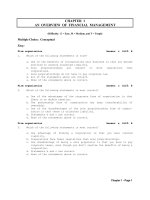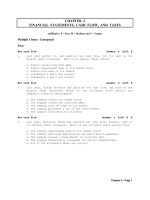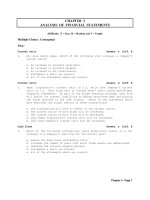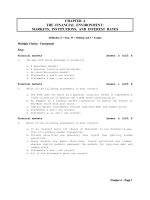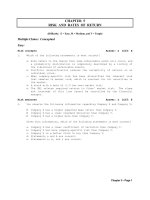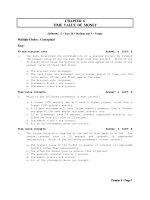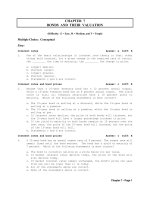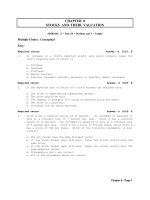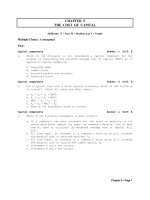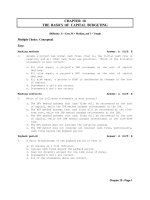Test bank accounting management 11e chapter 06 MASTER BUDGET AND RESPONSIBILITY ACCOUNTING
Bạn đang xem bản rút gọn của tài liệu. Xem và tải ngay bản đầy đủ của tài liệu tại đây (203.47 KB, 12 trang )
CHAPTER 6
MASTER BUDGET AND RESPONSIBILITY
ACCOUNTING
LEARNING OBJECTIVES
1. Understand what a master budget is and explain its benefits
2. Describe the advantages of budgets
3. Prepare the operating budget and its supporting schedules
4. Use computer-based financial planning models in sensitivity analysis
5. Explain kaizen budgeting and how it is used for cost management
6. Prepare an activity-based budget
7. Describe responsibility centers and responsibility accounting
8. Explain how controllability relates to responsibility accounting
CHAPTER OVERVIEW
Chapter 6 describes a major feature of management planning and control systems, budgets. The
importance of satisfying customers and succeeding in the marketplace compels the use of a common
accounting tool for planning and controlling, budgeting. As noted in the chapter, “Few businesses plan to
fail, but many of those that flop, failed to plan.” The chapter describes how budgeting is used in
implementing plans developed through strategic planning, assisting managers in their planning function.
Chapter 7 will describe how budgets aid managers in their control function. The wise and skillful
administration of the budget is what gives budgets value because budgets, in themselves, are neither good
nor bad.
The report models used in budgeting are familiar, as they are the basic financial statements. The
statements are approached from a different perspective, as typically projected sales are the starting point
for preparing a budget. In costing systems studied in the previous two chapters, sales are the result of
operations rather than the beginning consideration. Preparation of an operating budget is illustrated. Cash
budgeting, a part of financial budgeting, is illustrated in the appendix to the chapter.
The theme of continuous improvement is featured through a description of kaizen budgeting. For
organizations that use activity-based costing and activity-based management, activity-based budgeting
works back through the activity-based costing system using the same defined activities and relationships.
Responsibility accounting is introduced as a means of coordinating the efforts of all employees in an
organization to attain the goals described in the master budget. The notion of controllability is addressed.
The chapter closes with a crucial aspect of budgeting – the human factor. The importance of the role of
people in the budgeting process is acknowledged throughout the chapter.
CHAPTER OUTLINE
I.
Budgeting – common accounting tool companies use for planning and controlling to satisfy
customers and succeed in the marketplace
A. Budgets and the budgeting cycle
1. Budgets—assisting managers in their planning function
a. Quantitative expression of a proposed plan of action by management for a specified
period
b. An aid to coordinating what needs to be done to implement that plan
2. Budgeting cycle: guide to well-managed organizations {thought process/decision making}
a. Planning the performance of company as a whole as well as subunits: management at all
levels agree on what is expected
b. Providing a frame of reference, a set of specific expectations for use in comparing actual
results
c. Investigating variations from plans: makes possible corrective action after investigation
d. Planning again in light of feedback and changing conditions
3. Terms used
Learning Objective 1:
Understand what a master budget is and explain its benefits
a. Master budget
i.
Summarizes financial projections of all of company’s budgets and plans
ii. Expresses management’s operating and financing plans with formalized outline of
financial objectives and how to attain
iii. Provides a tool that is neither good nor bad, but valuable when administered skillfully
b.
Pro forma statements: term used for budgeted financial statements
Do multiple choice 1 and 2.
Learning Objective 2:
Describe the advantages of budgets
76 Chapter 6
Assign Problem 6-31.
B. Advantages and benefits of budgeting: big part of most management control systems
(Prepared when expected benefits exceed expected costs)
1. Compels strategic planning and implementation of plans
a. Considers strategy questions integral to company’s strategic analysis
b. Effects both long-run and short-run planning
c. Provides feedback that can signal revisions to plan and possibly strategies
2. Provides framework for judging performance
a. Can overcome limitation of using past results that incorporate miscues and substandard
performance
b. Can overcome limitation of using past performance when future conditions may be
expected to differ from the past
3. Motivates managers and employees
a. Individuals likely to work more intensely to avoid failure than to achieve success
b. A little anxiety improves performance
4. Promotes coordination and communication among subunits within the company
a. Need to think of relationships among individual operations, departments, company as a
whole, and across companies during budgeting process as well as production process for
satisfying customers
b. Need to have goals understood and accepted by all employees
C. Administration of budgets [Surveys of Company Practice]
1. Benefits of budgeting comes when management at all levels of company understand and
support the budget and all aspects of management control system
2. Top management support critical for obtaining active line-management participation
3. Attainment of budget should not be an end in itself
D. Time coverage of budgets
1. Purpose of budget should guide time period chosen
2. Ongoing coverage through use of rolling budget
Do multiple choice 3.
Assign Exercise 6-16.
Master Budget and Responsibility Accounting
77
II. The master budget
A. Financial budget: includes capital expenditures, cash, balance sheet, and cash flows
Learning Objective 3:
Prepare the operating budget and its supporting schedules
B. Steps in developing an operating budget: budgeted income statement and its supporting budget
schedules [Exhibit 6-2]
1. Step 1: Prepare the revenues budget: usual starting point in budgeting
2. Step 2: Prepare the production budget (in units)
3. Step 3: Prepare the direct materials usage and purchases budgets
4. Step 4: Prepare the direct manufacturing labor budget
5. Step 5: Prepare the manufacturing overhead budget
6. Step 6: Prepare the ending inventories budget
7. Step 7: Prepare the cost of goods sold budget
8. Step 8: Prepare the nonmanufacturing costs budget
9. Step 9: Prepare the budgeted income statement [Exhibit 6-3] [Concepts in Action]
Do multiple choice 4 and 5.
Assign Exercises 6-17 through 6-19 and Problems 6-30 and 6-34.
Learning Objective 4:
Use computer-based financial planning models in sensitivity analysis
C. Computer-based financial planning models – assist in sensitivity analysis
Do multiple choice 6.
Assign Problem 6-29.
D. Variations [Exhibit 6-4]
Learning Objective 5:
Explain kaizen budgeting and how it is used for cost management
1. Kaizen budgeting: based on idea it is possible to continuously reduce costs over time
Do multiple choice 7.
Assign Exercise 6-25 (a continuation of 6-24—and of 5-24).
Learning Objective 6:
Prepare an activity-based budget
2. Activity-based budgeting: focuses on budgeted costs of activities needed to produce and sell
products and services—emphasizes future costs and future use of activity areas
Do multiple choice 8.
Learning Objective 7:
78 Chapter 6
Assign Exercise 6-24 (see 5-24).
Describe responsibility centers and responsibility accounting
III. Responsibility accounting: system that measures the plans and actions of each responsibility center
A. Structure of organization shapes efforts of coordination—assigning responsibility to managers
who are accountable for actions in planning and controlling human and physical resources
1. Organization structure: an arrangement of lines of responsibility within the organization
a. Responsibility center: part , segment, or subunit of an organization whose manager is
accountable for a specified set of activities
i.
Cost center – manager accountable for costs only
ii. Revenue center – manager accountable for revenues only
iii. Profit center – manager accountable for revenues and costs
iv. Investment center – manager accountable for investments, revenues, and costs
b. Responsibility accounting: system that measures plans by budgets and actions by actual
results of each responsibility center
2. Feedback, use of variances—early warning, performance evaluation, and evaluating strategy
Do multiple choice 9.
Assign Exercises 6-25 and 6-26 and Problem 6-29.
Learning Objective 8:
Explain how controllability relates to responsibility accounting
B. Controllability: degree of influence that a specific manager has over costs, revenues, and related
items for which responsible
1. Difficult to pinpoint
a. Few costs clearly under influence of one manager
b. Long enough time span, all costs come under somebody’s control
2. Emphasis on information and behavior
a. Responsibility focuses on whom to ask to obtain information, not on whom to blame
b. Performance reports may include uncontrollable items because could change behavior in
directions top management desire
Do multiple choice 10.
Assign Problem 6-32.
IV. Human aspects of budgeting—human factors are a crucial part of budgeting
V. Cash budgeting [appendix]
Do multiple choice 11 and 12. Assign Exercise 6-27 and Problem 6-35.
CHAPTER QUIZ SOLUTIONS: 1.d
2.a 3.b 4.d 5.c 6.b 7.c 8.a 9.d 10.b 11.c
12.b
Master Budget and Responsibility Accounting
79
CHAPTER QUIZ
1. Budgeting is the common accounting tool companies use for planning and controlling. Budgets
a.
b.
c.
d.
2.
provide a measure of planned financial results.
focus managers’ energies on exploiting opportunities.
help managers anticipate potential problems.
enable managers to control through a set of specific activities with defined corrective actions.
[AICPA Adapted] Dewitt Co. budgeted its activity for October 2002 from the following information:
Sales are budgeted at $750,000. All sales are credit sales and a provision for doubtful accounts is
made monthly at the rate of 2% of sales.
Merchandise inventory was $120,000 at September 30, 2002, and an increase of $10,000 is
planned for the month.
All merchandise is marked up to sell at invoice cost plus 50%.
Estimated cash disbursements for selling and administrative expenses for the month are $105,000.
Depreciation for the month is projected at $25,000.
Dewitt is projecting operating income for October 2002 in the amount of
a. $105,000.
b. $119,000.
c. $129,000.
d. $230,000.
3. Which of the following is not a major benefit of budgets?
a. compels planning
b. eliminates innovation
c. provides performance criteria
d. promotes coordination and communication
The following data apply to questions 4 and 5.
Hester Company budgets on an annual basis for its fiscal year. The following beginning and ending
inventory levels (in units) are planned for the fiscal year of July 1, 2001, through June 30, 2002.
Raw material1
Work in process
Finished goods
1
July 1, 2001
40,000
8,000
30,000
June 30, 2002
10,000
8,000
5,000
Three (3) units of raw material are needed to produce each unit of finished product.
4. [CMA Adapted] If Hester Company plans to sell 500,000 units during the 2001-2002 fiscal year, the
number of units it would have to manufacture during the year would be
a. 505,000 units.
5.
b. 500,000 units.
c. 480,000 units.
d. 475,000 units.
[CMA Adapted] If 450,000 finished units were to be manufactured during the 2001-2002 fiscal year
by Hester Company, the units of raw material needed to be purchased would be
a. 1,350,000 units. b. 1,360,000 units.
c. 1,320,000 units.
d. 1,330,000 units.
6. Which of the following does not pertain to financial planning models in software form?
a. Reduces computational burden and time required to prepare budgets
b. Eliminates need to update budgets as uncertainty resolved
c. Assists managers with sensitivity analysis
80 Chapter 6
d. Performs calculations that are mathematical representations of relationships in master budget
7. The major cost management concept used in kaizen budgeting is that of
a.
b.
c.
d.
eliminating inventories of every type but materials.
refinements in the indirect-cost categories for costing systems.
continuous improvement.
sensitivity analysis using computer-based financial planning models.
8. Activity-based budgeting for a setup activity would require budgeting costs
a.
b.
c.
d.
separately for the setup activity.
for the department in which the setup activity would occur.
on a per unit basis for the number of units involved in the setup.
separately for variable and fixed categories for the setup activity.
9. Which of the following statements does not describe responsibility accounting?
a.
b.
c.
d.
It measures the plans and actions of each responsibility center.
It budgets to emphasize that for which each responsibility center is accountable.
It calculates variances between budgeted and actual for each responsibility center.
It identifies managers at fault for operating problems by reports for each responsibility center.
10. The important question to ask in explaining how controllability relates to responsibility accounting is:
a. Whom to blame?
b. Whom to
ask?
c. Whom to hold responsible?
d. Who has control?
The following data apply to questions 11 and 12 [Appendix]:
Information pertaining to Brenton Corporation's sales revenue is presented in the following table:
Cash sales
Credit sales
Total sales
February
March
April
$160,000
300,000
$460,000
$150,000
400,000
$550,000
$120,000
280,000
$400,000
Management estimates that 5% of credit sales are not collectible. Of the credit sales that are collectible,
60% are collected in the month of sale and the remainder in the month following the sale. Cost of
purchases of inventory each month are 70% of the next month's projected total sales. All purchases of
inventory are on account; 25% are paid in the month of purchase, and the remainder is paid in the month
following the purchase.
11. [CMA Adapted] Brenton's budgeted total cash receipts in April are
a. $448,000.
b. $437,000.
c. $431,600.
d. $328,000.
12. [CMA Adapted] Brenton's budgeted total cash payments in March for inventory purchases are
a. $385,000.
b. $358,750.
c. $306,250.
d. $280,000.
Master Budget and Responsibility Accounting
81
WRITING/DISCUSSION EXERCISES
1. Understand what a master budget is and explain its benefits
Describe the evolution of a management control system, including how budgets became
a major feature of that system. In a small, new organization, personal observation is usually the
dominant means of control. A manager sees, touches, and hears the relationship between inputs and
outputs; he or she oversees the work and actions of various personnel.
Over time, managers add historical records to their personal observations. Historical records allow
managers to compare current performance with past performance. How well were customer needs
satisfied in the current year compared with last year? Analyses of past performance can help improve
future performance. Managers must deal with a series of periods, not just one at a time.
As the organization matures, budgeting becomes an important step in the growth and improvement of the
accounting system. A manager would find it helpful to compare actual performance in the current year
with the plans prepared for the current year. Budgeting systems help promote this future perspective.
2. Describe the advantages of budgets
If budgeting is filling in the financial statements with “what-if” numbers, why is
budgeting considered such a major task and so important to an organization? The
mechanics of preparing a budget may seem simplistic. What lies behind the numbers is of consequence.
A budget is similar to a blueprint. Before the process of drawing out the blueprints for a building or piece
of equipment, many factors have to be considered. Of particular importance for a company are the
objectives and the strategy to accomplish those. If the objectives are clear and the strategy determined,
people must make it happen over a period of time in a variety of environments. And even the nicest of
blueprints must give way to events and unforeseen circumstances. Blueprints, as initially developed, do
not often become floor plans. For who would not want to take advantage of having better materials used
or a slightly different design if the opportunity arose. An ancient proverb expresses some of the problem
in developing a budget, “Many a slip ‘twixt cup and lip.” It is not possible to plan for everything, and yet
the process of budgeting requires thinking about most things and incorporating all possibilities to the
extent they are cost/beneficial.
Computers have decreased the importance of technical number-crunching skills, allowing the focus to
shift to strategy and the human aspects of budgeting.
82 Chapter 6
3. Prepare the operating budget and its supporting schedules
Why is budgeting described as an accounting tool? Accounting is the language of business. A
language has conventions and structure that enable communication to take place. Budgets are a proposed
plan of action by management for a future time period for the business or organization as a whole. To
communicate ideas and criteria throughout the organization, language is necessary. Accounting provides
that communication tool—language. The advantages that budgets provide are those typical of a language.
The advantage of putting ideas into concrete plans, of expressing expectations into performance criteria,
and of making aspirations into common goals and objectives.
Accounting provides key information to managers for the purpose of making decisions. Information is
provided by means of language. Accounting is the language of business, using both financial and
nonfinancial terms.
4. Use computer-based financial planning models in sensitivity analysis
Sensitivity analysis was discussed in earlier chapters. How are these references
related? Sensitivity analysis was discussed in Chapter 3 for cost-volume-profit analysis. The technique
of examining how a result will change if the original predicted data are not achieved or if underlying
assumptions change is pervasive in costing systems. Except for actual costing systems, estimates or
assumptions are an integral aspect of the system.
Chapter 6 uses financial accounting statements, including the absorption costing income statement, as the
basis of developing the operating and production budgets rather than the variable costing approach to the
income statement. As part of “sensitivity analysis” one could examine the “what-if” of using different
methods to report information. For example, in problem 6-30 in the text Thingone and Thingtwo are
products produced in greater quantity than expected sales. An income statement prepared using
absorption costing will differ from one prepared using variable costing. Would a manager make a
different decision if using one type rather than the other? Which is right? Sensitivity analysis can include
being sensitive to the methods used as well as predicted data and model assumptions.
5. Explain kaizen budgeting and its importance for cost management
Everyone should use kaizen budgeting because the objective of continuous improvement is
important to every organization. Why isn’t kaizen budgeting considered the basic approach to
preparing a budget? Budgets, by their very nature of compelling planning, require thinking toward
improvement. Kaizen is a specific budgetary approach that explicitly incorporates continuous
improvement. Because of its explicit nature, to be used appropriately and properly, kaizen budgeting
would have to be learned. The cost-benefit guideline recognizes that learning is a cost. Not all
organizations would benefit more than the cost of learning the specific method of kaizen and applying
that particular type of budgeting.
As with activity-based costing or other approaches that would change the way in which a company
accounted for its operations, an organization would need to consider costs compared to benefits before
attempting implementation. If a company’s strategy and overall objectives would be better served by the
use of a particular approach, typically the benefits would outweigh the costs over a period of time. The
strategy is primary; the specific accounting approaches to helping managers administer and coordinate
activities must reflect that strategy.
Master Budget and Responsibility Accounting
83
6. Prepare an activity-based budget
Aren’t activity-based costing and activity-based management enough without adding
activity-based budgeting too? Refer to Learning Objective 1 for description of the evolution of a
management control system. The text notes in the section on activity-based budgeting that the domain of
activity-based costing is the reporting and analysis of past and current costs. A natural extension is to use
an activity-based approach in the budgeting of future costs within an activity-based costing system. This
is an example of a management control system evolving.
7. Describe responsibility centers and responsibility accounting
How does the saying, “The whole is more than the sum of its parts,” apply to
responsibility accounting? Requiring budgets and reports from individual units within the larger
organization provides information useful for the whole. In preparing budgets, each unit must consider its
role in the larger organization and work toward coordinating efforts for achieving company goals as well
as individual goals. With the requirement of reporting activities by individual unit, individual feedback
can be linked with other units for comparison and evaluation. Careful and wise selection of individual
units can result in more effort toward achieving the organization’s goals, better information for making
decisions, and more useful performance reports. With each individual unit working to achieve its own
objectives and those of the overall organization, more can be accomplished. Energy to the organization is
lost if one group is working in a way that is counterproductive to the whole. Responsible accounting or
reporting can contribute to identifying such behavior.
8. Explain how controllability relates to responsibility accounting
How can it possibly be advantageous to an organization to hold a person responsible for
things beyond her/his control? The idea of holding a person responsible for costs or revenues for
which s/he has little or no control can be used to promote certain types of behavior, for eliciting
information, and to broaden perspective. The concept of what is “controllable” changes with time and
circumstance. To hold no one controllable is probably to have no control. To overemphasize
controllability could lead to undesirable behavior that would not promote the interests of the company as
a whole.
84 Chapter 6
Worksheet for Computing Units –
Production & Direct Materials Purchases
(With no change in Work-in-Process Inventory amount from beginning to ending)
Finished Goods Inventory: units
Direct Materials Inventory: units
Beginning
Beginning
+ Production ____________
“conversion”
+ Purchase
_____________
DM units
Available
for sale
to FG units
Available
for use
or
− Ending
Goods sold
____________
FG units to
DM units
− Ending
____________
Units used
Master Budget and Responsibility Accounting
85
SUGGESTED READINGS
Birnberg, J., “The Role of Behavioral Research in Management Accounting Education in the 21 st
Century,” Issues in Accounting Education (November 2000) p.713 [16p].
Diehn, D., “Seven Steps to Build a Successful Collaborative Forecasting Process,” Journal of Business
Forecasting Methods and Systems (Winter 2000/2001) p.23 [3p].
Hope, J. and Fraser, R., “Beyond Budgeting,” Strategic Finance (October 2000) p.30 [6p].
Kahn, K., “Sales Forecasting as a Knowledge Management Process,” Journal of Business Forecasting
Methods and Systems (Winter 2000/2001) p.19 [4p].
Kanter, J., “Have We Forgotten the Fundamental IT Enabler: Ease of Use?” Information Systems
Management (Summer 2000) p.70 [8p].
Latimer, M., “Linking Strategy-Based Costing and Innovation-Based Budgeting,” Strategic Finance
(March 2001) p.38 [5p].
Popcorn, F. and Marigold, L., Clicking (1997), HarperBusiness, New York NY.
Tambrino, P., “Contribution Margin Budgeting,” Community College Journal of Research and Practice
(January 2001) p.29 [8p].
Walker, K. & Johnson, E., “The Effects of a Budget-Based Incentive Compensation Scheme on the
Budgeting Behavior of Managers and Subordinates,” Journal of Management Accounting Research
(1999) p.1 [28p].
Welsch, G., Hilton, R. & Gordon, P., Budgeting: Profit Planning and Control (1988), Prentice-Hall,
Englewood Cliffs, NJ.
Werges, B., “An Integrated Planning Process to Improve Margins, Turnover and Order Fulfillments,”
Journal of Business Forecasting Methods and Systems (Spring 1999) p.19 [3p].
86 Chapter 6
